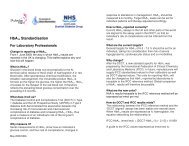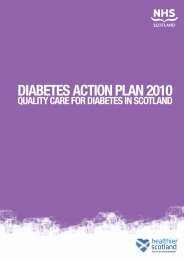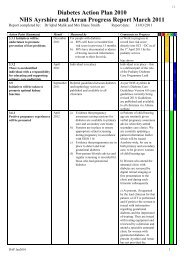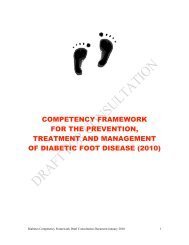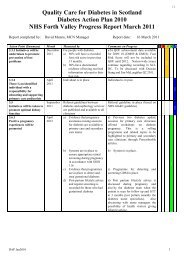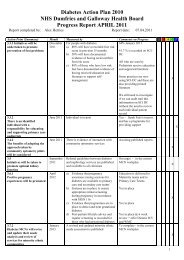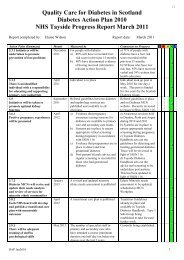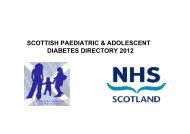NHS Forth Valley Insulin Pump Action Plan - Diabetes in Scotland
NHS Forth Valley Insulin Pump Action Plan - Diabetes in Scotland
NHS Forth Valley Insulin Pump Action Plan - Diabetes in Scotland
You also want an ePaper? Increase the reach of your titles
YUMPU automatically turns print PDFs into web optimized ePapers that Google loves.
DRAFT<br />
<strong>NHS</strong> <strong>Forth</strong> <strong>Valley</strong> <strong>Insul<strong>in</strong></strong> <strong>Pump</strong> Therapy <strong>Action</strong> <strong>Plan</strong> 2012/13 to<br />
2014/15 onwards (DRAFT)<br />
1. Introduction<br />
This document provides an overview of the <strong>Forth</strong> <strong>Valley</strong> action plan <strong>in</strong> relation to CEL(4) 2012.<br />
<strong>Forth</strong> <strong>Valley</strong> is committed work<strong>in</strong>g towards the targets for improv<strong>in</strong>g access to <strong>in</strong>sul<strong>in</strong> pump<br />
therapy. This draft action plan for implementation looks ma<strong>in</strong>ly at the next three years, with<br />
some <strong>in</strong>dication of ensur<strong>in</strong>g a susta<strong>in</strong>able service thereafter. There are a number of challenges<br />
and risks identified <strong>in</strong> the plan, which we will look to mitigate over the period. These issues will<br />
be reviewed and the plans changed accord<strong>in</strong>gly as and when required.<br />
2. Background<br />
a. <strong>NHS</strong>FV Project Team<br />
On the 5 th of March, the <strong>Forth</strong> <strong>Valley</strong> <strong>Insul<strong>in</strong></strong> <strong>Pump</strong> Therapy Project Team was established to<br />
discuss the CEL, the current pump therapy services and the work of the Team. It was agreed<br />
that the Team would focus on:<br />
<br />
<br />
<br />
<br />
<br />
<br />
Clarify<strong>in</strong>g the current position<br />
Identify<strong>in</strong>g and assess<strong>in</strong>g the project challenges, risks and issues (<strong>in</strong>clud<strong>in</strong>g cl<strong>in</strong>ical,<br />
f<strong>in</strong>ancial and timescales)<br />
Work<strong>in</strong>g through the options for achiev<strong>in</strong>g the targets<br />
Develop<strong>in</strong>g an action plan (<strong>in</strong>clud<strong>in</strong>g resources, f<strong>in</strong>ances, phas<strong>in</strong>g of the <strong>in</strong>creases,<br />
communications)<br />
Oversee<strong>in</strong>g the implementation of the project<br />
Oversee<strong>in</strong>g the report<strong>in</strong>g of progress<br />
Project Team membership <strong>in</strong>cludes:<br />
Graham Foster, <strong>Diabetes</strong> MCN Lead David Munro, <strong>Diabetes</strong> MCN Manager<br />
Cl<strong>in</strong>ician<br />
Kathryn Fraser, <strong>Diabetes</strong> Dietitian Hillary Whitty, Lead <strong>Diabetes</strong> Nurse<br />
George Naguib, Associate Specialist, Chris Kelly, Consultant Physician<br />
Paediatrics<br />
Mel Robertson, Team Leader, Women Claud<strong>in</strong>e MacMurdo, Accountant<br />
and Children’s Unit<br />
Ian Aitken, General Manager Lorna Henry, Service Manager,<br />
Medical Specialties<br />
John Schulga, Consultant Paediatrician Helen Bauld, Department Manager<br />
(Paediatrics/ Neonates)<br />
Mary Miller, Service/ Nurse Manger, Gillian Morton, General Manager,<br />
Women and Children’s Unit<br />
Women and Children’s Unit<br />
Pam Paul, AHP Manager, Acute Fiona Struthers, Dietetic Co-ord<strong>in</strong>ator,<br />
Services<br />
FVRH<br />
Version 1.0 27 March 2012 1
DRAFT<br />
The Project Team meet<strong>in</strong>gs will be chaired by Dr John Schulga.<br />
This Team agreed the number and type of pumps required for use <strong>in</strong> 2012/ 13, which was<br />
submitted to the Scottish Government on the 15 th March 2012. This draft action plan was<br />
developed by the Project Team and signed off by Fiona Ramsay (Director of F<strong>in</strong>ance) and Ia<strong>in</strong><br />
Wallace (Medical Director) prior to submission.<br />
3. Assessment of the Situation<br />
a. Analysis of the current services<br />
i. Paediatric Service (current profile)<br />
The paediatric service will support children from 0 to =16 years of age to < 18 years of age and<br />
adults (i.e. >= 18 years of age). There are limited cl<strong>in</strong>ical resources support<strong>in</strong>g the local pump<br />
therapy service. Expertise <strong>in</strong> this area has been developed s<strong>in</strong>ce a small <strong>in</strong>vestment <strong>in</strong> the<br />
service <strong>in</strong> 2006. However, this service has now reached capacity.<br />
The current service supports 37 adults and young adults. The future service will need to support<br />
up to 88 adults and young adults.<br />
b. Analysis of the Challenges and Risks<br />
The Project Team identified a number of challenges and risks. These are summarised below:<br />
Current Service/ New Service<br />
No dedicated paediatric pump service <strong>in</strong> place currently<br />
A transition service must be put <strong>in</strong> place for patients on pumps<br />
Cl<strong>in</strong>ical governance arrangements for the develop<strong>in</strong>g service need to be addressed<br />
Pre-pump carbohydrate count<strong>in</strong>g education needs to be supported<br />
Outpatient cl<strong>in</strong>ic space/ support is required<br />
Medical records support is required for cl<strong>in</strong>ics<br />
The service needs to be robust and susta<strong>in</strong>able and not rely on only a few key staff<br />
A susta<strong>in</strong>able level of service needs to be put <strong>in</strong> place for year 4 onwards<br />
Version 1.0 27 March 2012 2
DRAFT<br />
<br />
The number of patients on pumps is likely to rise year on year. Children with pumps will<br />
move through to the adult service and new children will be added to ensure that the 25%<br />
target is ma<strong>in</strong>ta<strong>in</strong>ed. The numbers of children with type 1 diabetes rises by<br />
approximately 30 per year <strong>in</strong> <strong>Forth</strong> <strong>Valley</strong>.<br />
Staff and Skills<br />
Staff time is not currently available to support an expansion <strong>in</strong> service<br />
Staff skills need to be developed to support a paediatric pump service<br />
Staff will be required to shadow teams/ <strong>in</strong>dividuals from other services across the country<br />
Staff will be required to undertake formal, certified tra<strong>in</strong><strong>in</strong>g courses<br />
We will need to backfill paediatric nurs<strong>in</strong>g time and paediatric dietitian time to support<br />
staff tra<strong>in</strong><strong>in</strong>g and service delivery.<br />
Tra<strong>in</strong><strong>in</strong>g of paediatric nurs<strong>in</strong>g staff and a paediatric dietitian is required<br />
Need to backfill some time of a consultant paediatrician/ associate specialist<br />
Consultant paediatric medical <strong>in</strong>put will be more <strong>in</strong>tensive dur<strong>in</strong>g year 1 to ensure that the<br />
develop<strong>in</strong>g service is well supported and embedded appropriately<br />
We need to backfill a consultant physician and dietitian for the adult service<br />
Potential options and the practicalities for backfill<strong>in</strong>g key staff (adult and children’s<br />
services) have not yet been <strong>in</strong>vestigated fully<br />
Project Management<br />
The Scottish Government is look<strong>in</strong>g for a <strong>Pump</strong> <strong>Action</strong> <strong>Plan</strong> by 23 March 2012. Although<br />
a draft action plan will be submitted by 27 Mach 2012, this will need to be reviewed,<br />
ref<strong>in</strong>ed and updated over the com<strong>in</strong>g weeks and months.<br />
A high level of new starts suggested for paediatric service <strong>in</strong> year 1, which is a challenge.<br />
Due to an <strong>in</strong>itial tra<strong>in</strong><strong>in</strong>g phase it is unlikely that new patient starts will happen until July<br />
2012, leav<strong>in</strong>g 9 months to meet the target.<br />
Concentration of adult new starts <strong>in</strong> years 2 and 3 is suggested, which is an <strong>in</strong>creased<br />
challenge (we will consider meet<strong>in</strong>g the adult target over years 1, 2 and 3).<br />
Additional resources required to support implementation will be need to be confirmed<br />
quickly so that time pressures are m<strong>in</strong>imised<br />
F<strong>in</strong>d<strong>in</strong>g enough patients to meet the targets may be challeng<strong>in</strong>g (a communication<br />
strategy will need to be developed for target groups). Targets may need to be extended<br />
over a longer time-scale.<br />
Many patients need to be approached to meet these targets as a number are likely to<br />
decl<strong>in</strong>e the offer to take on the challenge of pump therapy<br />
F<strong>in</strong>ancial/ Strategic<br />
The recurr<strong>in</strong>g cost is significant. In addition to the year 1 purchase of pumps and<br />
consumables for children, there will be additional costs <strong>in</strong>curred locally regard<strong>in</strong>g <strong>in</strong>sul<strong>in</strong><br />
and critically staff<strong>in</strong>g resources (and pumps and consumables for adults). An <strong>in</strong>itial<br />
review of the additional resources required <strong>in</strong>dicates an annual recurr<strong>in</strong>g spend of £70K<br />
on new pumps, £72K on staff and £106K on consumables and <strong>in</strong>sul<strong>in</strong> (after any MDI<br />
sav<strong>in</strong>gs) on average. There are significant peaks with<strong>in</strong> the 4 year f<strong>in</strong>ancial plan due to<br />
the pattern of pump replacement.<br />
Version 1.0 27 March 2012 3
DRAFT<br />
<br />
<br />
<br />
<br />
<br />
<br />
<br />
The f<strong>in</strong>ancial implications of this develop<strong>in</strong>g service will need to be reviewed aga<strong>in</strong>st the<br />
overarch<strong>in</strong>g <strong>NHS</strong> <strong>Forth</strong> <strong>Valley</strong>-wide plann<strong>in</strong>g process and priorities on an annual basis<br />
(This will <strong>in</strong>clude an analysis of the actual take-up of pump therapy aga<strong>in</strong>st our current<br />
planned level of take-up of pump therapy. Timescales for achievement of the targets may<br />
need to be reviewed annually, depend<strong>in</strong>g on local <strong>in</strong>terest from suitable <strong>Forth</strong> <strong>Valley</strong><br />
residents).<br />
A pump replacement programme is required for a much higher level of pumps than<br />
current levels<br />
THE CEL states that additional costs should be met from the Board’s f<strong>in</strong>ancial allocation<br />
<strong>in</strong> future years (which will have a range of other commitments aga<strong>in</strong>st it also)<br />
Any difference between the <strong>Forth</strong> <strong>Valley</strong> and the Scottish cost/ sav<strong>in</strong>gs profiles may be a<br />
challenge<br />
We have used Scottish Government estimates <strong>in</strong> some places (e.g. MDI sav<strong>in</strong>gs)<br />
The level of any likely sav<strong>in</strong>gs are as yet unknown<br />
Sign<strong>in</strong>g off a fully costed <strong>Forth</strong> <strong>Valley</strong> action plan with<strong>in</strong> the timescales will be a challenge<br />
(this will need to be reviewed and ref<strong>in</strong>ed over the com<strong>in</strong>g weeks and months)<br />
c. Preferred Option for Implementation<br />
The CEL states that year 1 of the Project should concentrate on <strong>in</strong>creas<strong>in</strong>g access to those<br />
DRAFT<br />
The project Team developed detailed staff<strong>in</strong>g profiles to support these elements and these are<br />
<strong>in</strong>cluded <strong>in</strong> the service specifications.<br />
4. Implementation<br />
The Project Team is asked to start to implement the preferred option from 1 April 2012. The key<br />
steps over the next quarter will be:<br />
To ensure that all local stakeholders are <strong>in</strong>formed of the way ahead<br />
To ensure that key staff are backfilled to support tra<strong>in</strong><strong>in</strong>g and service implementation<br />
To ensure that key staff have the necessary skills, expertise and experience<br />
To ref<strong>in</strong>e the service specification<br />
To ensure that the resources are <strong>in</strong> place to support the planned expansion of local<br />
<strong>in</strong>sul<strong>in</strong> pump therapy services<br />
To agree a communications strategy and start to target groups of patients<br />
To ensure that local people with Type 1 diabetes are given the <strong>in</strong>formation they need to<br />
make an <strong>in</strong>formed choice regard<strong>in</strong>g their therapy options<br />
To agree a schedule of monthly pump <strong>in</strong>creases across year 1, 2 and 3<br />
To develop a more detailed action plan<br />
To support service managers to implement the proposals<br />
To review performance aga<strong>in</strong>st the plan<br />
To monitor progress and report back to the <strong>NHS</strong>FV Lead Executive and the Scottish<br />
Government<br />
Version 1.0 27 March 2012 5




